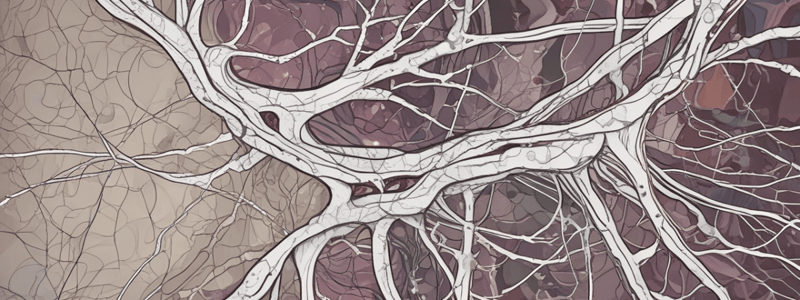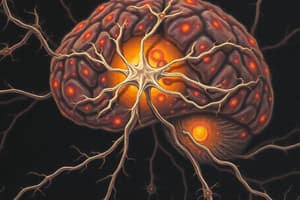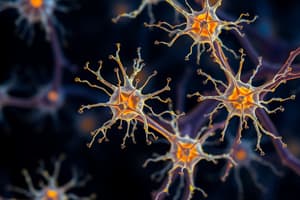Podcast
Questions and Answers
What is the primary function of oligodendrocytes in the nervous system?
What is the primary function of oligodendrocytes in the nervous system?
- Forming myelin sheaths around axons (correct)
- Maintaining ion balance and providing metabolic support to neurons
- Regulating the immune response in the CNS
- Maintaining the blood-brain barrier phenotype
What is the term for the wave of calcium that can spread through a population of astrocytes via gap junctions or extra-cellular signaling?
What is the term for the wave of calcium that can spread through a population of astrocytes via gap junctions or extra-cellular signaling?
- Electrical synapse
- Neurotransmitter release
- Tripartite synapse
- Calcium wave mechanism (correct)
Which type of glial cell is derived from foetal macrophages and plays a role in the immune response in the CNS?
Which type of glial cell is derived from foetal macrophages and plays a role in the immune response in the CNS?
- Schwann cells
- Astrocytes
- Oligodendrocytes
- Microglia (correct)
What is the term for the process by which astrocytes take up potassium ions from the extracellular space and regulate its concentration?
What is the term for the process by which astrocytes take up potassium ions from the extracellular space and regulate its concentration?
What is the term for the structure that incorporates astrocytes into the traditional synaptic structure and regulates synaptic activity?
What is the term for the structure that incorporates astrocytes into the traditional synaptic structure and regulates synaptic activity?
What is the term for the process by which astrocytes release products of arachidonic acid metabolism to control vasodilation and vasoconstriction?
What is the term for the process by which astrocytes release products of arachidonic acid metabolism to control vasodilation and vasoconstriction?
What is the term for the process by which astrocytes take up glutamate from the extracellular space and convert it to glutamine?
What is the term for the process by which astrocytes take up glutamate from the extracellular space and convert it to glutamine?
Which type of glial cell is responsible for maintaining the blood-brain barrier phenotype?
Which type of glial cell is responsible for maintaining the blood-brain barrier phenotype?
What is the term for the process by which astrocytes undergo a reactive response to injury, isolating the damaged area and reconstructing the blood-brain barrier?
What is the term for the process by which astrocytes undergo a reactive response to injury, isolating the damaged area and reconstructing the blood-brain barrier?
What is the term for the type of glial cell that provides structural support, insulation, and nutrients to neurons?
What is the term for the type of glial cell that provides structural support, insulation, and nutrients to neurons?
What is the primary mechanism by which astrocytes maintain ion balance in the nervous system?
What is the primary mechanism by which astrocytes maintain ion balance in the nervous system?
What is the characteristic morphology of astrocytes?
What is the characteristic morphology of astrocytes?
Which type of glial cell is responsible for forming myelin sheaths around axons?
Which type of glial cell is responsible for forming myelin sheaths around axons?
What is the term for the process by which astrocytes and neurons communicate through the release of signalling molecules?
What is the term for the process by which astrocytes and neurons communicate through the release of signalling molecules?
What is the role of astrocytes in the regulation of cerebral blood flow?
What is the role of astrocytes in the regulation of cerebral blood flow?
Which type of glial cell is derived from neural precursor cells and can differentiate into myelinating and non-myelinating cells?
Which type of glial cell is derived from neural precursor cells and can differentiate into myelinating and non-myelinating cells?
What is the term for the structure that forms a network-like structure in the nervous system, providing structural support and insulation to neurons?
What is the term for the structure that forms a network-like structure in the nervous system, providing structural support and insulation to neurons?
Which type of glial cell plays a role in the immune response in the nervous system?
Which type of glial cell plays a role in the immune response in the nervous system?
What is the term for the process by which astrocytes provide metabolic support to neurons, involving the uptake of glucose and release of lactate?
What is the term for the process by which astrocytes provide metabolic support to neurons, involving the uptake of glucose and release of lactate?
What is the characteristic feature of astrocytes that allows them to regulate synaptic activity?
What is the characteristic feature of astrocytes that allows them to regulate synaptic activity?
What is the primary function of astrocytes in the nervous system?
What is the primary function of astrocytes in the nervous system?
Which type of glial cell is characterized by fine processes that wind around axons to form myelin sheaths?
Which type of glial cell is characterized by fine processes that wind around axons to form myelin sheaths?
What is the mechanism by which astrocytes regulate synaptic activity?
What is the mechanism by which astrocytes regulate synaptic activity?
What is the characteristic feature of astrocytes that allows them to maintain ion balance in the nervous system?
What is the characteristic feature of astrocytes that allows them to maintain ion balance in the nervous system?
What is the role of gap junctions in the nervous system?
What is the role of gap junctions in the nervous system?
Which type of glial cell is responsible for the recycling of glutamate in the nervous system?
Which type of glial cell is responsible for the recycling of glutamate in the nervous system?
What is the term for the process by which astrocytes provide metabolic support to neurons?
What is the term for the process by which astrocytes provide metabolic support to neurons?
What is the characteristic feature of astrocytes that allows them to regulate cerebral blood flow?
What is the characteristic feature of astrocytes that allows them to regulate cerebral blood flow?
What is the role of astrocytes in the immune response in the nervous system?
What is the role of astrocytes in the immune response in the nervous system?
What is the characteristic feature of astrocytes that allows them to modulate synaptic activity?
What is the characteristic feature of astrocytes that allows them to modulate synaptic activity?
Study Notes
Distinction between Neurons and Glial Cells
- Neurons transmit information through electrical and chemical signals
- Glial cells provide structural support, insulation, and nutrients to neurons, and play a role in immune response and modulating synaptic activity
Astrocytes
- Morphology: star-like shape (stellate) with numerous branching processes
- Physiological properties: maintain ion balance, provide metabolic support to neurons, and regulate neurotransmitter levels
- Calcium wave mechanism: form syncytium, allowing Ca2+ waves to spread through astrocyte populations via gap junctions or extra-cellular signaling
Oligodendrocytes
- Morphology: fine processes end as flat sheets that wind around axons to form myelin sheaths
- Function: NG2-expressing glia, derivative of oligodendrocyte precursor cells (OPCs), form contacts including synapses with neurons, and may persist as multipotent adult stem cells
Microglia
- Cell lineage: fetal macrophages to embryonic microglial cells to amoeboid microglia in the corpus callosum to resting microglia
- Function: immunocompetent cells in CNS, forming the brain's immune system
Schwann Cells
- Types: myelinating and non-myelinating Schwann cells
- Cell lineage: start from neural precursor cell to Schwann cell precursor to immature Schwann cell, then differentiate to myelinating and non-myelinating cells
- Phenotype determined by radial sorting, depending on contact with axon and axon diameter
Phylogeny of Glia and Neurons
- During evolution: increase in glia:neuron ratio, greater changes in astrocytes than neurons, and increase in size and complexity of astrocytes
Cell-Cell Signalling
- Chemical synapses: released neurotransmitter acts on metabotropic or ionotropic receptors across the synaptic cleft
- Electrical synapses: gap junctions (connexin molecules) bridging the gap
- Tripartite synapse: incorporates astrocytes into the traditional synaptic structure, regulating synaptic activity by uptake of neurotransmitters, release of gliotransmitters, and regulation of extracellular ion concentrations
Types of Transmission/Signalling
- Wiring: point-to-point communication between neurons via synapses
- Volume transmission: diffusion of signalling molecules in the extracellular space, influencing a broader area of the NS
Homeostasis Involving Astrocytes
- K+ buffering/regulation: astrocytes take up K+ away from sites of neural activity
- Water regulation: movement of K+ and glutamate allows water to move osmotically, and astrocytes have a high density of AQP4 water channels
- Recycling of glutamate: astrocytes use glutamate transporters to take up neuronally released glutamate and convert it to glutamine for return to presynaptic terminal
- Maintenance of BBB phenotype: astrocytes contribute to the expression of tight junction proteins and polarized expression of ion channels/transporters on capillary endothelial cells
- Astrocyte-neuronal lactate shuttle: glucose is taken up by astrocyte transporters and converted to lactate, passed to neurons as an energy source via monocarboxylic acid transporters (MCT)
- Regulation of cerebral blood flow: astrocytes control vasodilation and vasoconstriction by releasing the products of arachidonic acid (AA) metabolism
- Astrocyte injury response: undergo reactive astrogliosis, isolating the damaged area, reconstructing the BBB, and facilitating the remodelling of brain circuits in areas surrounding the lesioned region
Distinction between Neurons and Glial Cells
- Neurons transmit information through electrical and chemical signals
- Glial cells provide structural support, insulation, and nutrients to neurons, and play a role in immune response and modulating synaptic activity
Astrocytes
- Morphology: star-like shape (stellate) with numerous branching processes
- Physiological properties: maintain ion balance, provide metabolic support to neurons, and regulate neurotransmitter levels
- Calcium wave mechanism: form syncytium, allowing Ca2+ waves to spread through astrocyte populations via gap junctions or extra-cellular signaling
Oligodendrocytes
- Morphology: fine processes end as flat sheets that wind around axons to form myelin sheaths
- Function: NG2-expressing glia, derivative of oligodendrocyte precursor cells (OPCs), form contacts including synapses with neurons, and may persist as multipotent adult stem cells
Microglia
- Cell lineage: fetal macrophages to embryonic microglial cells to amoeboid microglia in the corpus callosum to resting microglia
- Function: immunocompetent cells in CNS, forming the brain's immune system
Schwann Cells
- Types: myelinating and non-myelinating Schwann cells
- Cell lineage: start from neural precursor cell to Schwann cell precursor to immature Schwann cell, then differentiate to myelinating and non-myelinating cells
- Phenotype determined by radial sorting, depending on contact with axon and axon diameter
Phylogeny of Glia and Neurons
- During evolution: increase in glia:neuron ratio, greater changes in astrocytes than neurons, and increase in size and complexity of astrocytes
Cell-Cell Signalling
- Chemical synapses: released neurotransmitter acts on metabotropic or ionotropic receptors across the synaptic cleft
- Electrical synapses: gap junctions (connexin molecules) bridging the gap
- Tripartite synapse: incorporates astrocytes into the traditional synaptic structure, regulating synaptic activity by uptake of neurotransmitters, release of gliotransmitters, and regulation of extracellular ion concentrations
Types of Transmission/Signalling
- Wiring: point-to-point communication between neurons via synapses
- Volume transmission: diffusion of signalling molecules in the extracellular space, influencing a broader area of the NS
Homeostasis Involving Astrocytes
- K+ buffering/regulation: astrocytes take up K+ away from sites of neural activity
- Water regulation: movement of K+ and glutamate allows water to move osmotically, and astrocytes have a high density of AQP4 water channels
- Recycling of glutamate: astrocytes use glutamate transporters to take up neuronally released glutamate and convert it to glutamine for return to presynaptic terminal
- Maintenance of BBB phenotype: astrocytes contribute to the expression of tight junction proteins and polarized expression of ion channels/transporters on capillary endothelial cells
- Astrocyte-neuronal lactate shuttle: glucose is taken up by astrocyte transporters and converted to lactate, passed to neurons as an energy source via monocarboxylic acid transporters (MCT)
- Regulation of cerebral blood flow: astrocytes control vasodilation and vasoconstriction by releasing the products of arachidonic acid (AA) metabolism
- Astrocyte injury response: undergo reactive astrogliosis, isolating the damaged area, reconstructing the BBB, and facilitating the remodelling of brain circuits in areas surrounding the lesioned region
Distinction between Neurons and Glial Cells
- Neurons transmit information through electrical and chemical signals
- Glial cells provide structural support, insulation, and nutrients to neurons, and play a role in immune response and modulating synaptic activity
Astrocytes
- Morphology: star-like shape (stellate) with numerous branching processes
- Physiological properties: maintain ion balance, provide metabolic support to neurons, and regulate neurotransmitter levels
- Calcium wave mechanism: form syncytium, allowing Ca2+ waves to spread through astrocyte populations via gap junctions or extra-cellular signaling
Oligodendrocytes
- Morphology: fine processes end as flat sheets that wind around axons to form myelin sheaths
- Function: NG2-expressing glia, derivative of oligodendrocyte precursor cells (OPCs), form contacts including synapses with neurons, and may persist as multipotent adult stem cells
Microglia
- Cell lineage: fetal macrophages to embryonic microglial cells to amoeboid microglia in the corpus callosum to resting microglia
- Function: immunocompetent cells in CNS, forming the brain's immune system
Schwann Cells
- Types: myelinating and non-myelinating Schwann cells
- Cell lineage: start from neural precursor cell to Schwann cell precursor to immature Schwann cell, then differentiate to myelinating and non-myelinating cells
- Phenotype determined by radial sorting, depending on contact with axon and axon diameter
Phylogeny of Glia and Neurons
- During evolution: increase in glia:neuron ratio, greater changes in astrocytes than neurons, and increase in size and complexity of astrocytes
Cell-Cell Signalling
- Chemical synapses: released neurotransmitter acts on metabotropic or ionotropic receptors across the synaptic cleft
- Electrical synapses: gap junctions (connexin molecules) bridging the gap
- Tripartite synapse: incorporates astrocytes into the traditional synaptic structure, regulating synaptic activity by uptake of neurotransmitters, release of gliotransmitters, and regulation of extracellular ion concentrations
Types of Transmission/Signalling
- Wiring: point-to-point communication between neurons via synapses
- Volume transmission: diffusion of signalling molecules in the extracellular space, influencing a broader area of the NS
Homeostasis Involving Astrocytes
- K+ buffering/regulation: astrocytes take up K+ away from sites of neural activity
- Water regulation: movement of K+ and glutamate allows water to move osmotically, and astrocytes have a high density of AQP4 water channels
- Recycling of glutamate: astrocytes use glutamate transporters to take up neuronally released glutamate and convert it to glutamine for return to presynaptic terminal
- Maintenance of BBB phenotype: astrocytes contribute to the expression of tight junction proteins and polarized expression of ion channels/transporters on capillary endothelial cells
- Astrocyte-neuronal lactate shuttle: glucose is taken up by astrocyte transporters and converted to lactate, passed to neurons as an energy source via monocarboxylic acid transporters (MCT)
- Regulation of cerebral blood flow: astrocytes control vasodilation and vasoconstriction by releasing the products of arachidonic acid (AA) metabolism
- Astrocyte injury response: undergo reactive astrogliosis, isolating the damaged area, reconstructing the BBB, and facilitating the remodelling of brain circuits in areas surrounding the lesioned region
Studying That Suits You
Use AI to generate personalized quizzes and flashcards to suit your learning preferences.
Description
This quiz covers the distinction between neurons and glial cells, including their structures and functions in the nervous system. Learn about the roles of astrocytes and other glial cells in supporting neurons and modulating synaptic activity.





